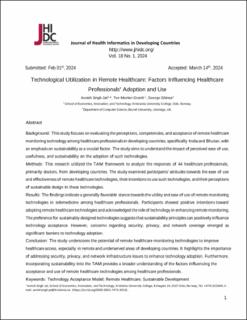| dc.description.abstract | Background: This study focuses on evaluating the perceptions, competencies, and acceptance of remote healthcare monitoring technology among healthcare professionals in developing countries, specifically India and Bhutan, with an emphasis on sustainability as a crucial factor. The study aims to understand the impact of perceived ease of use, usefulness, and sustainability on the adoption of such technologies.
Methods: This research utilized the TAM framework to analyze the responses of 44 healthcare professionals, primarily doctors, from developing countries. The study examined participants' attitudes towards the ease of use and effectiveness of remote healthcare technologies, their intentions to use such technologies, and their perceptions of sustainable design in these technologies.
Results: The findings indicate a generally favorable stance towards the utility and ease of use of remote monitoring technologies in telemedicine among healthcare professionals. Participants showed positive intentions toward adopting remote healthcare technologies and acknowledged the role of technology in enhancing remote monitoring. The preference for sustainably designed technologies suggests that sustainability principles can positively influence technology acceptance. However, concerns regarding security, privacy, and network coverage emerged as significant barriers to technology adoption.
Conclusion: The study underscores the potential of remote healthcare monitoring technologies to improve healthcare access, especially in remote and underserved areas of developing countries. It highlights the importance of addressing security, privacy, and network infrastructure issues to enhance technology adoption. Furthermore, incorporating sustainability into the TAM provides a broader understanding of the factors influencing the acceptance and use of remote healthcare technologies among healthcare professionals. | en_US |

